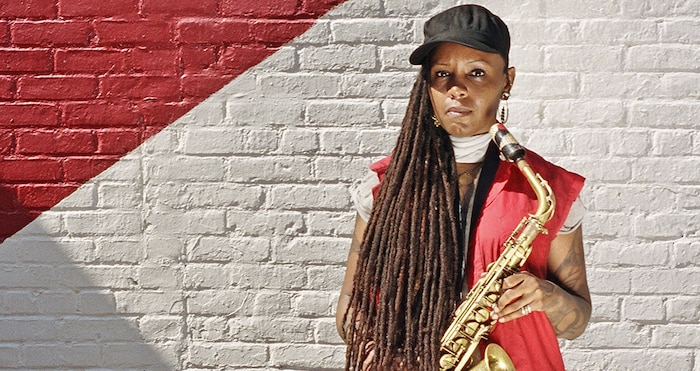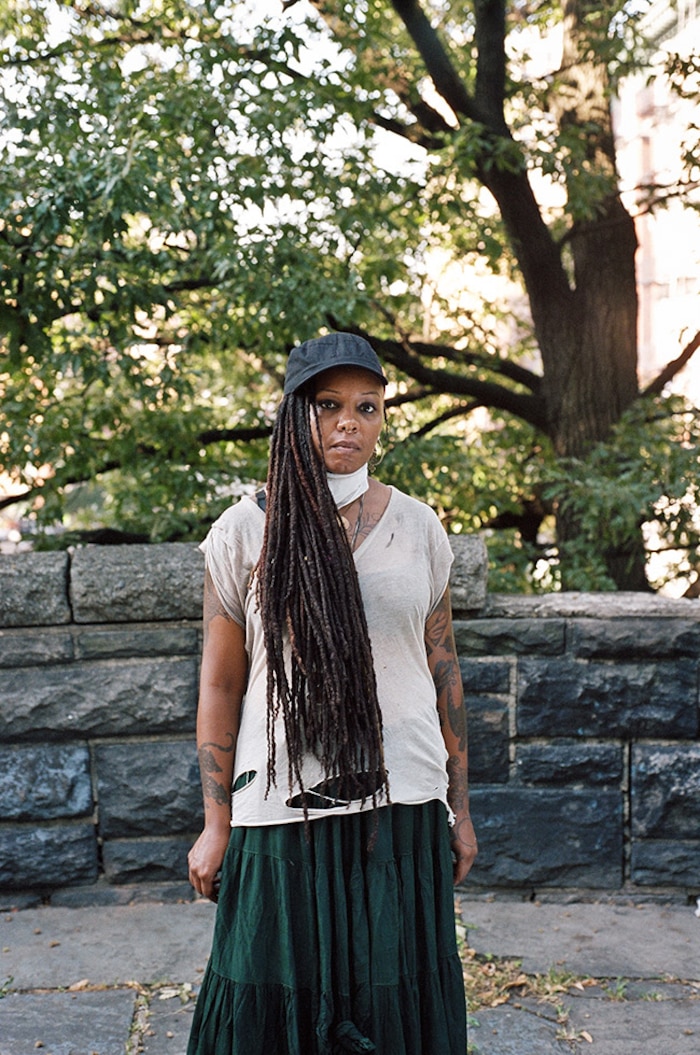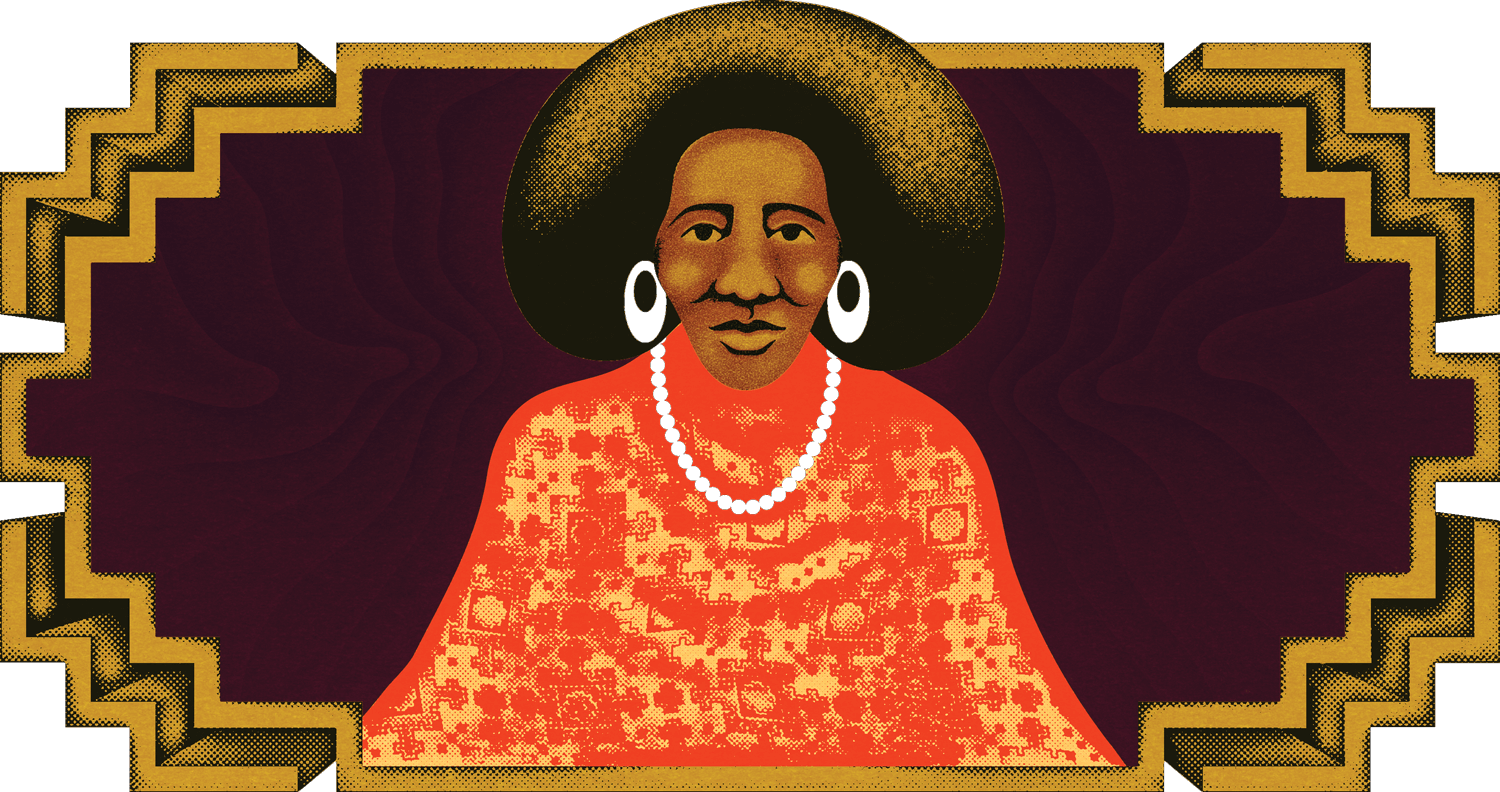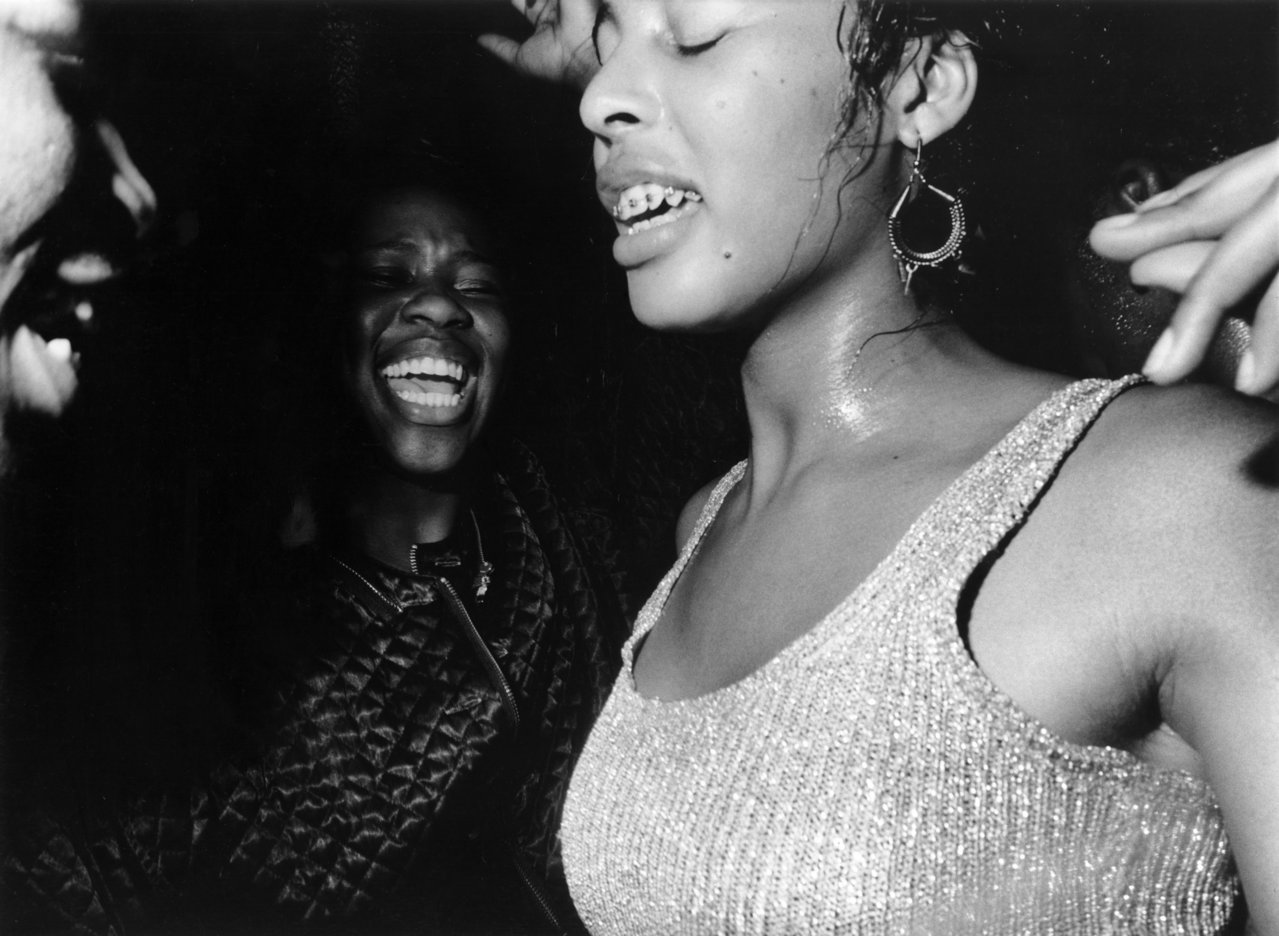Interview: Composer and Saxophonist Matana Roberts
Britt Robson catches up with the sound experimentalist upon the release of her third edition in the Coin Coin series.

It is not too preposterous to say that Matana Roberts is assembling a new type of musical expression. Her 12-chapter Coin Coin project, which is now one-quarter of the way finished nearly a decade after its initial conception, is an ambitious attempt to mix history, memory and visceral personal ancestry together in songs layered to evoke a “fever dream” ambiance.
Coin Coin is named after a freed slave and businesswoman in Louisiana during the 18th Century. Roberts, a Chicago native now in her mid-30s, says that “My interest in creating this work came from my childhood fascination with ghosts, spirits, spooks and the faint traces of what they leave behind…In some instances I am using information that I gleaned from research into my own ancestral history, as inspiration and area of creative consideration.” Though Roberts has noted in the past that the musical root of much of this work also stems from an “attraction/repulsion to certain aspects of the American Jazz tradition(s),” her focus for sound extends way beyond jazz.
The following interview is comprised of two email exchanges that occurred right around the release of Coin Coin Chapter Three: River Run Thee, an album recorded shortly before she began living on a houseboat in Brooklyn. Coin Coin Chapter One: Gens de Couleur Libres, was recorded with a 16-piece band and released in 2011. Coin Coin Chapter Two: Mississippi Moonchile, was written for her New York-based sextet and released in 2013. River Run Thee is her first chapter to be recorded as a solo work. Both separately and together, they present a dazzling mosaic upon Coin Coin’s epic canvas.

At your direction, I went to the Constellation Records site to get a description of this massive Coin Coin project. How did you come to organize it?
I had about 10 to 12 segments of history as it relates to bits and pieces of my American ancestry that I wanted to explore. I wanted to have multiple opportunities to challenge myself as a composer, so it felt right.
How much of a flexible organism has the process been as you’ve moved forward? I understand that you have changed some of the ordering. Have the catalysts for those decisions generally been artistic license regarding a clearer perception of the work or more mundane circumstantial stuff?
More mundane, but also just following through with how the work is telling me it would like to travel onwards. It’s a constant exploration of give and take with my inner muse. We don’t always get along.
I especially like the horns on Chapter Three. They often feel like narrative ghosts in the mix. Do you have those kinds of assignations, about what the sounds represent, or is it very haphazard and just suits the prevailing mix?
My goal was to create a fever dream of sorts, that kind of dream where there is more memory encased than is apparent when you are really dreaming. So everything is placed in the mix that way on purpose – including the vocals/horns that are not 100 percent clear.
You have written about the difficulty of Chapter Three being a more solo work. But has that enabled you to experiment with it more and indulge your imagination in-process?
I’m using the solo work to work on my interest in lo-fi moving image and also trying to codify the language system I am putting on my ensemble in the paper scores. It’s helping me to really aim towards better sound specificity. If I can’t translate the language I’m trying to use in my graphic scores myself, it’s not fair to put that on other people.
Many other composers use “graphic scores” with various types of unorthodox cues, including Anthony Braxton, Sun Ra and Darius Jones.
Unorthodox cueing is not what I’m really speaking of when I use the term graphic – I am speaking of the actual score as visual object. Many of the cues I use I learned from Butch Morris’s conduction system. But the cue aspect is a very small part, it’s more about the actual score when I use the term, not the directives.
The lineage of graphic score notation I am dealing with though is more from these folks: Pauline Oliveros, John Cage, Ladonna Smith, John Zorn, Wadada Leo Smith, Marina Rosenfeld, Lamonte Young, Terry Riley, Brian Eno, Miya Masaoka, Kay Gardner, George Lewis, Steve Lacy, Joelle Leandre. Lots of Fluxus artists – oh and a lot of Charles Ives (his scores are really fascinating, though not traditionally “graphic” in the manner I am speaking). I also have an interest in early Gregorian chant, mid-century Appalachian shape note singing, and notational systems from other cultures like Japan, India and Indonesia, as well as placement of African and indigenous oral traditions within the scores.
I love the “fever dream” concept behind your collages. It fits with your recognition that chaos and burial in layers intensifies listener concentration. It also feeds the kind of dislocation that suits both the long-ago chronology of slave times and the intense woe built into the subject. What is your DJ/mixology background? Did you have mentors?
Mixology is a big part of my lifestyle in terms of surviving as a lo-fi arts person.
I know a lot of Chicago improviser and experimental folks who are amaaaaazing DJs (Josh Abrams, Jeff Parker, Damon Locks, etc). And I dabble a little myself (I’m substandard compared to them, it’s a tad embarrassing). It’s kind of a secret life (not anymore!) that gives me a lot of pleasure. But you know I kind of grew up in the age of the musical pastiche in pop culture and in some sense during some of the best years of hip hop, punk, indie rock, which most definitely feeds into my aesthetic as a collagist. Mixology is a big part of my lifestyle in terms of surviving as a lo-fi arts person, trying to find value in things that folks toss away, piecing them together in a way that interests me, that evokes a certain beauty. The DJ thing teaches you a lot about people and how sound affects people.
How applicable are these folks to the current project and how much have you had to invent on your own? Knowing how many layers and how and when they separate or obfuscate must ultimately be intuitive, right?
Yeah, I’m a crafts person at heart more than an “artist” and craftwork is very much about intuitiveness, the energy of the moment to me.
Is there a sense of “sonic daguerreotype” that you are after? Also, a sense of audio happenstance, which is the way historical information is so often conveyed? I guess what I am asking with this barrage of questions is how important is your knowledge of DJ culture to the formation of this chapter and to Coin Coin in general?
I mean the primacy of the ear is most important to me, the documentation of an aural/oral history is most important to me – and then everything else follows. The rise of DJ culture has always played a role in my life, between DJs and the mixtape you know? Punk rock mixtapes changed my life. And then I grew up around people who were deeply devoted to vinyl. My first memories of touching something that people in my family deemed valuable (that I sometimes wasn’t allowed to touch) was vinyl. So it’s all intertwined for me.
I grew up during the introduction of MTV and then was exposed to visual artists who had a bit of the collagist aesthetic in their own work: folks like Romare Bearden, Basquiat, Joseph Cornell, Betye Saar, Robert Rauschenberg. Then I was exposed to outsider artists like Kea Tawana, Henry Darger, Mary T. Smith and then whole African American yard art tradition. I spent time in one neighborhood in Chicago, where I had extended family, where this guy used his entire front and backyard to place these huge, brightly painted wooden collage sculptures, surrounded by flowers and gardens. A lot of the adults in the neighborhood hated him for it, but I loved it. The ugliest sculpture was in the front yard: He titled it “mother in law.” I knew another elder guy that made collage-like crowns for fun, filled a whole house with them, owned nothing else.
And then, back to youth culture, through punk fanzines that were literally these little collages passed around with a lot of love. And graffiti writers had a huge influence on me for a while. Bomb the Suburbs, written by a Chicago bomber, changed my life in a sense, as did the ancient skin collage tradition of tattooing.
Amid all these fever-dream layers, what does get revealed can be very strategic. In particular, it doesn’t seem like a coincidence that the bulk of the verbal or lyrical information occurs at the beginning and end of “River Run Thee.” I am particularly struck by some of the lines in the song “All Is Written.” For example, “I live by the rules of eternity…but now my conscience scorns me.” And another one is “Why do we try so hard? Because we should.” The first speaks to discouragement and the second to motivation, as if you are explaining why you – or Captain Sullivan, the seaman who rescues slaves whose log you use in the work – try to tackle such a monumental task in the first place. Or am I working too hard at drawing connections?
It’s entirely up to you. Some of the words placed on that record I don’t agree with, but they asked to be a part of this and so it’s my job as a craftsperson to listen to what the materials I am working with are telling me. I enjoy that one line, “because we should,” because that’s my value system front and center right there. But I don’t believe in sadness growing as “years roll by” [another lyric in Chapter Three] – sadness only grows if you feed it.
Another lyric that deserves mention is on the song “Nema Nema Nema.” You sing about “where the holy cannot hide.” How does religion play out for you in this saga? Because it is such a spiritual project and yet keen for history and fact too.
Well, I can’t deal with the history of America without dealing with the role of religious faith. I have never quite understood faith up until this phase of my life, where I have seen friends and loved ones die too soon. It seems to me that it becomes useful when faced with questions that refuse to give you the answer you’d prefer. But at the same time, I believe in faith in those things that are bigger than yourself. Nature really gives me a lot to hold onto in that.
Knowing history gives me so much joy. It reminds me every day that I live a life of real privilege.
A couple of specific things. “As Years Roll By” feels like a break from the burden, a shaft of happiness relative to much of what has come before. Is that purposeful? Do you worry about “depressing” people with the depth of the truth you are telling? Also, there are more recognizable songs toward the end, and of course an iconic voice in Malcolm X near the close. Is this part of the emergence from the “fever dream”?
The solo records of the series [Chapter Three is the first to be recorded] are the most autobiographical. I have always been accused of being overly sentimental or overly melancholic, so it’s a pretty good representation in that sense, I feel. The Malcolm X sample is in there because his aesthetic was part of my childhood. History can be really depressing and I do worry about that with the series as a whole, but knowing history gives me so much joy. It reminds me every day that I live a life of real privilege and you can not have the happy without the sad, so I do my best to even it out and hope for the best.
You alluded to this briefly, but your time on the houseboat communing more concretely with the natural world changed you some.
Not so much changed me, just reminded me of parts of my value system I was beginning to forget about.
And I know that your mother’s death had an enormous impact on you just before the first chapter.
Yes, I am not the same person, a parent dying young is very hard to take. When she died I lost a part of myself I will not see again, but change – even if sad and traumatic – is good. Change is the only dependable factor in a life.
So how have you changed since initiating the project and how do you imagine that has in turn changed your art and work?
Well, that’s a hard question to really answer truthfully because it’s an instinctual feeling as well, and I’m still sorting it all out...
What do you suspect we will see from your changes in the chapters ahead?
I really can’t tell you. I follow my muses. I listen to them. [It] goes back and forth. Sometimes we do not get along, but I follow through because I really feel I’m being used as a channel and a lot of what I’m doing will not make much sense to me until I’m at the end of this life. At least that is my hope...

